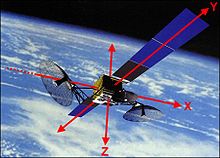Solar Array Drive Mechanism
A Solar Array Drive Mechanism (SADM), in English mechanism for rotating solar modules , is a device on three-axis stabilized satellites that uses a suitable motor-gear construction to optimally align the solar cells with the sun and thereby transfer the energy generated by them to the satellite . In the case of a geostationary satellite, the axis of the solar panels lies i. d. R. in north-south direction, d. H. perpendicular to the direction of flight and parallel to the earth.
A SADM is technically very demanding because on the one hand high electrical power of up to 25 kW (with voltages up to 120 V, with lower power 50 V is usual) and control signals via slip rings from the solar panels to the satellite, on the other hand it is very robust and Reliability is required. In particular, the selection, design and insulation of the grinding elements is critical. Lubricants for mechanics , for example, also pose a particular challenge in space. The SADM is exposed to high mechanical loads during take-off and also during the unfolding process of the solar panels. In the case of low orbits, there is also constant mechanical stress on the drive train, as one revolution is usually required per orbit. As a result, important elements are designed to be redundant, as is common for space applications.
Special applications with limited range of motion can also work with a cable loop or a twistable cable bundle. Two-axis designs are also possible if the required orientation towards the sun cannot otherwise be guaranteed.
